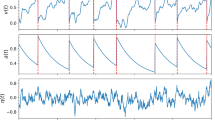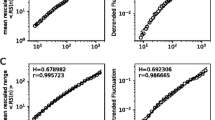Abstract
A neuron receives input from other neurons via electrical pulses, so-called spikes. The pulse-like nature of the input is frequently neglected in analytical studies; instead, the input is usually approximated to be Gaussian. Recent experimental studies have shown, however, that an assumption underlying this approximation is often not met: Individual presynaptic spikes can have a significant effect on a neuron’s dynamics. It is thus desirable to explicitly account for the pulse-like nature of neural input, i.e. consider neurons driven by a shot noise – a long-standing problem that is mathematically challenging. In this work, we exploit the fact that excitatory shot noise with exponentially distributed weights can be obtained as a limit case of dichotomous noise, a Markovian two-state process. This allows us to obtain novel exact expressions for the stationary voltage density and the moments of the interspike-interval density of general integrate-and-fire neurons driven by such an input. For the special case of leaky integrate-and-fire neurons, we also give expressions for the power spectrum and the linear response to a signal. We verify and illustrate our expressions by comparison to simulations of leaky-, quadratic- and exponential integrate-and-fire neurons.








Similar content being viewed by others
References
Abramowitz, M., & Stegun, I.A. (1972). Handbook of mathematical functions with formulas, graphs and mathematical tables. New York: Dover.
Badel, L., Lefort, S., Brette, R., Petersen, C.C., Gerstner, W., & Richardson, M.J. (2008). Dynamic IV curves are reliable predictors of naturalistic pyramidal-neuron voltage traces. Journal of Neurophysiology, 99(2), 656–666.
Bena, I. (2006). Dichotomous Markov noise: exact results for out-of-equilibrium systems. International Journal of Modern Physics B, 20(20), 2825–2888.
Boucsein, C., Tetzlaff, T., Meier, R., Aertsen, A., & Naundorf, B. (2009). Dynamical response properties of neocortical neuron ensembles: multiplicative versus additive noise. Journal of Neuroscience, 29(4), 1006–1010.
Braitenberg, V., & Schüz, A. (1998). Cortex: statistics and geometry of neuronal connectivity. Heidelberg, Berlin: Springer.
van den Broeck, C. (1983). On the relation between white shot noise, Gaussian white noise, and the dichotomic Markov process. Journal of Statistical Physics, 31(3), 467–483.
Brunel, N. (2000). Dynamics of sparsely connected networks of excitatory and inhibitory spiking neurons. Journal of Computational Neuroscience, 8(3), 183–208.
Brunel, N., & Latham, P.E. (2003). Firing rate of the noisy quadratic integrate-and-fire neuron. Neural Computation, 15(10), 2281–2306.
Brunel, N., & Sergi, S. (1998). Firing frequency of leaky intergrate-and-fire neurons with synaptic current dynamics. Journal of Theoretical Biology, 195(1), 87–95.
Brunel, N., Chance, F.S., Fourcaud, N., & Abbott, L.F. (2001). Effects of synaptic noise and filtering on the frequency response of spiking neurons. Physical Review Letters, 86, 2186–2189.
Doose, J., Doron, G., Brecht, M., & Lindner, B. (2016). Noisy juxtacellular stimulation in vivo leads to reliable spiking and reveals high-frequency coding in single neurons. The Journal of Neuroscience, 36(43), 11,120–11,132.
Droste, F. (2015). Signal transmission in stochastic neuron models with non-white or non-Gaussian noise. Humboldt-Universität zu Berlin: PhD thesis.
Droste, F., & Lindner, B. (2014). Integrate-and-fire neurons driven by asymmetric dichotomous noise. Biological Cybernetics, 108(6), 825–843.
Droste, F., & Lindner, B. (2017). Exact results for power spectrum and susceptibility of a leaky integrate-and-fire neuron with two-state noise. Physical Review E, 95, 012–411.
Fourcaud, N., & Brunel, N. (2002). Dynamics of the firing probability of noisy integrate-and-fire neurons. Neural Computation, 14(9), 2057–2110.
Fourcaud-Trocmé, N., Hansel, D., Van Vreeswijk, C., & Brunel, N. (2003). How spike generation mechanisms determine the neuronal response to fluctuating inputs. The Journal of Neuroscience, 23(37), 11,628–11,640.
Gardiner, C.W. (1985). Handbook of stochastic methods. Heidelberg: Springer.
Gerstein, G.L., & Mandelbrot, B. (1964). Random walk models for the spike activity of a single neuron. Biophysical Journal, 4, 41.
Helias, M., Deger, M., Diesmann, M., & Rotter, S. (2010a). Equilibrium and response properties of the integrate-and-fire neuron in discrete time. Frontiers in Computational Neuroscience, 3, 29.
Helias, M., Deger, M., Rotter, S., & Diesmann, M. (2010b). Instantaneous non-linear processing by pulse-coupled threshold units. PLoS Conput Biol, 6(9), e1000–929.
Helias, M., Deger, M., Rotter, S., & Diesmann, M. (2011). Finite post synaptic potentials cause a fast neuronal response. Frontiers in Neuroscience, 5, 19.
Holden, A.V. (1976). Models of the stochastic activity of neurones. Heidelberg: Springer.
Ikegaya, Y., Sasaki, T., Ishikawa, D., Honma, N., Tao, K., Takahashi, N., Minamisawa, G., Ujita, S., & Matsuki, N. (2013). Interpyramid spike transmission stabilizes the sparseness of recurrent network activity. Cerebral Cortex, 23(2), 293–304.
Ilin, V., Malyshev, A., Wolf, F., & Volgushev, M. (2013). Fast computations in cortical ensembles require rapid initiation of action potentials. Journal of Neuroscience, 33, 2281.
Jacobsen, M., & Jensen, A.T. (2007). Exit times for a class of piecewise exponential Markov processes with two-sided jumps. Stochastic Processes and their Applications, 117(9), 1330–1356.
Lefort, S., Tomm, C., Sarria, J.C.F., & Petersen, C.C. (2009). The excitatory neuronal network of the C2 barrel column in mouse primary somatosensory cortex. Neuron, 61(2), 301–316.
Lindner, B., & Schimansky-Geier, L. (2001). Transmission of noise coded versus additive signals through a neuronal ensemble. Physical Review Letters, 86, 2934–2937.
Lindner, B., Schimansky-Geier, L., & Longtin, A. (2002). Maximizing spike train coherence or incoherence in the leaky integrate-and-fire model. Physical Review E, 66, 031–916.
Lindner, B., Longtin, A., & Bulsara, A. (2003). Analytic expressions for rate and CV of a type I neuron driven by white Gaussian noise. Neural Computation, 15(8), 1761–1788.
Loebel, A., Silberberg, G., Helbig, D., Markram, H., Tsodyks, M., & Richardson, M.J. (2009). Multiquantal release underlies the distribution of synaptic efficacies in the neocortex. Frontiers in Computational Neuroscience 3.
Ly, C., & Tranchina, D. (2007). Critical analysis of dimension reduction by a moment closure method in a population density approach to neural network modeling. Neural Computation, 19, 2032.
Mankin, R., Ainsaar, A., & Reiter, E. (1999). Trichotomous noise-induced transitions. Physical Review E, 60, 1374–1380.
Markram, H., Lübke, J., Frotscher, M., Roth, A., & Sakmann, B. (1997). Physiology and anatomy of synaptic connections between thick tufted pyramidal neurones in the developing rat neocortex. Journal of Physiology, 500(Pt 2), 409.
Masoliver, J. (1987). First-passage times for non-Markovian processes: Shot noise. Physical Review A, 35(9), 3918.
Moreno, R., de La Rocha, J., Renart, A., & Parga, N. (2002). Response of spiking neurons to correlated inputs. Physical Review Letters, 89(28), 288–101.
Moreno-Bote, R., Renart, A., & Parga, N. (2008). Theory of input spike auto-and cross-correlations and their effect on the response of spiking neurons. Neural Computation, 20(7), 1651–1705.
Novikov, A., Melchers, R., Shinjikashvili, E., & Kordzakhia, N. (2005). First passage time of filtered Poisson process with exponential shape function. Probabilistic Engineering Mechanics, 20(1), 57–65.
Nykamp, D.Q., & Tranchina, D. (2000). A population density approach that facilitates large-scale modeling of neural networks: Analysis and an application to orientation tuning. Journal of Computational Neuroscience, 8, 19.
Ostojic, S., Szapiro, G., Schwartz, E., Barbour, B., Brunel, N., & Hakim, V. (2015). Neuronal morphology generates high-frequency firing resonance. Journal of Neuroscience, 35(18), 7056–7068.
Ricciardi, L.M., & Sacerdote, L. (1979). The Ornstein-Uhlenbeck process as a model for neuronal activity. Biological Cybernetics, 35, 1.
Richardson, M.J., & Gerstner, W. (2005). Synaptic shot noise and conductance fluctuations affect the membrane voltage with equal significance. Neural Computation, 17(4), 923–947.
Richardson, M.J., & Swarbrick, R. (2010). Firing-rate response of a neuron receiving excitatory and inhibitory synaptic shot noise. Physical Review Letters, 105(17), 178–102.
Richardson, M.J.E. (2004). Effects of synaptic conductance on the voltage distribution and firing rate of spiking neurons. Physical Review E, 69(5 Pt 1), 051–918.
Richardson, M.J.E., & Gerstner, W. (2006). Statistics of subthreshold neuronal voltage fluctuations due to conductance-based synaptic shot noise. Chaos, 16(2), 026–106.
de la Rocha, J., Doiron, B., Shea-Brown, E., Josic, K., & Reyes, A. (2007). Correlation between neural spike trains increases with firing rate. Nature, 448, 802.
Rosenbaum, R., & Josic, K. (2011). Mechanisms that modulate the transfer of spiking correlations. Neural Computation, 23, 1261.
Schwalger, T., Droste, F., & Lindner, B. (2015). Statistical structure of neural spiking under non-Poissonian or other non-white stimulation. Journal of Computational Neuroscience, 39, 29–51.
Siegert, A.J.F. (1951). On the first passage time probability problem. Physical Review, 81, 617–623.
Sirovich, L. (2003). Dynamics of neuronal populations: eigenfunction theory; some solvable cases. Network, 14 (2), 249–272.
Sirovich, L., Omurtag, A., & Knight, B. (2000). Dynamics of neuronal populations: The equilibrium solution. SIAM Journal on Applied Mathematics, 60(6), 2009–2028.
Song, S., Sjöström, P.J., Reigl, M., Nelson, S., & Chklovskii, D.B. (2005). Highly nonrandom features of synaptic connectivity in local cortical circuits. PLoS Biology, 3(3), e68.
Stein, R.B. (1965). A theoretical analysis of neuronal variability. Biophysical Journal, 5, 173.
Stein, R.B., French, A.S., & Holden, A.V. (1972). The frequency response, coherence, and information capacity of two neuronal models. Biophysical Journal, 12, 295.
Tchumatchenko, T., Malyshev, A., Wolf, F., & Volgushev, M. (2011). Ultrafast Population Encoding by Cortical Neurons. The Journal of Neuroscience, 31, 12–171.
Thomson, A.M., Deuchars, J., & West, D.C. (1993). Large, deep layer pyramid-pyramid single axon EPSPs in slices of rat motor cortex display paired pulse and frequency-dependent depression, mediated presynaptically and self-facilitation, mediated postsynaptically. Journal of Neurophysiology, 70(6), 2354– 2369.
Tsurui, A., & Osaki, S. (1976). On a first-passage problem for a cumulative process with exponential decay. Stochastic Processes and their Applications, 4(1), 79–88.
Tuckwell, H.C. (1988). Introduction to theoretical neurobiology: (Vol. 2): nonlinear and stochastic theories Vol. 8. Cambridge: Cambridge University Press.
Vilela, R.D., & Lindner, B. (2009a). Are the input parameters of white noise driven integrate and fire neurons uniquely determined by rate and CV? Journal of Theoretical Biology, 257(1), 90–99.
Vilela, R.D., & Lindner, B. (2009b). Comparative study of different integrate-and-fire neurons: Spontaneous activity, dynamical response, and stimulus-induced correlation. Physical Review E, 80, 031–909.
Wolff, L., & Lindner, B. (2008). Method to calculate the moments of the membrane voltage in a model neuron driven by multiplicative filtered shot noise. Physical Review E, 77, 041–913.
Wolff, L., & Lindner, B. (2010). Mean, variance, and autocorrelation of subthreshold potential fluctuations driven by filtered conductance shot noise. Neural Computation, 22(1), 94–120.
Acknowledgements
This work was funded by the BMBF (FKZ:01GQ1001A), the DFG research training group GRK1589/1, and a DFG research grant (LI 1046/2-1).
Author information
Authors and Affiliations
Corresponding author
Ethics declarations
Conflict of interests
The authors declare that they have no conflict of interest
Additional information
Action Editor: Brent Doiron
Appendix A: Expressions for ϕ(v) for various neuron models
Appendix A: Expressions for ϕ(v) for various neuron models
Here, we list explicit expressions for
for PIF, LIF and QIF neurons.
-
PIF (f(v) = μ):
$$ {\phi}(v) = v \left( \frac{1}{a} + \frac{\tau_{\mathrm{m}} r_{\text{in}}}{\mu} \right). $$(28) -
LIF (f(v) = μ − v):
$$ {\phi}(v)= \frac{v}{a} - \tau_{\mathrm{m}} r_{\text{in}} \ln(|\mu-v|). $$(29) -
QIF (f(v) = μ + v 2):
$$ {\phi}(v)\,=\, \frac{v}{a} + \frac{\tau_{\mathrm{m}} r_{\text{in}}}{\sqrt{|\mu|}} \left\{\begin{array}{lll} \arctan\left( \frac{v}{\sqrt{\mu}} \right) & \mu > 0 \\ \!-\text{arctanh}\left( \frac{v}{\sqrt{-\mu}} \right) & \,-\,\sqrt{-\mu} < v \!<\! \sqrt{\,-\,\mu} \\ -\text{arccoth}\left( \frac{v}{\sqrt{-\mu}} \right) & \text{otherwise} \\ \end{array}\right.. $$(30)
Rights and permissions
About this article
Cite this article
Droste, F., Lindner, B. Exact analytical results for integrate-and-fire neurons driven by excitatory shot noise. J Comput Neurosci 43, 81–91 (2017). https://doi.org/10.1007/s10827-017-0649-5
Received:
Revised:
Accepted:
Published:
Issue Date:
DOI: https://doi.org/10.1007/s10827-017-0649-5




